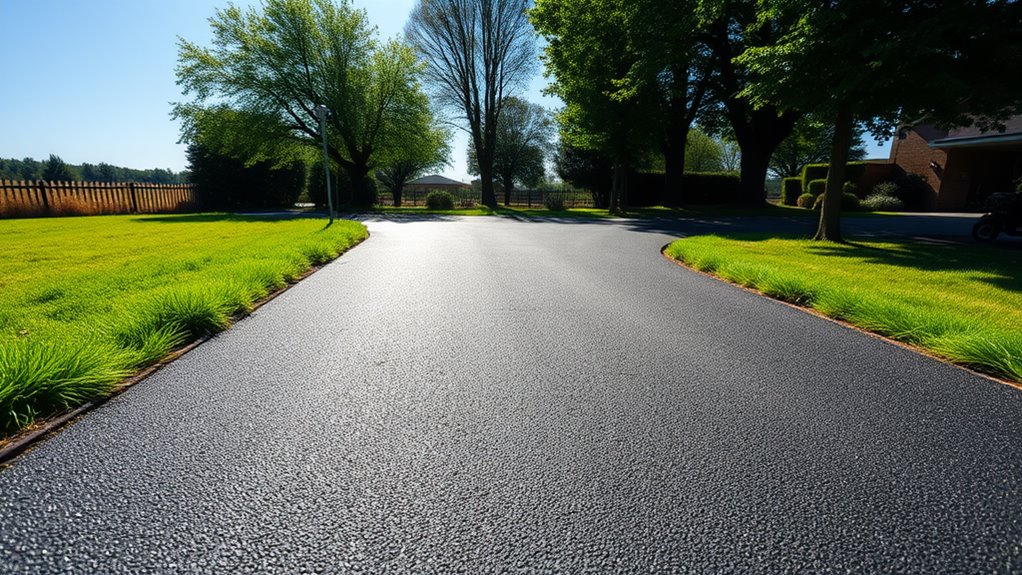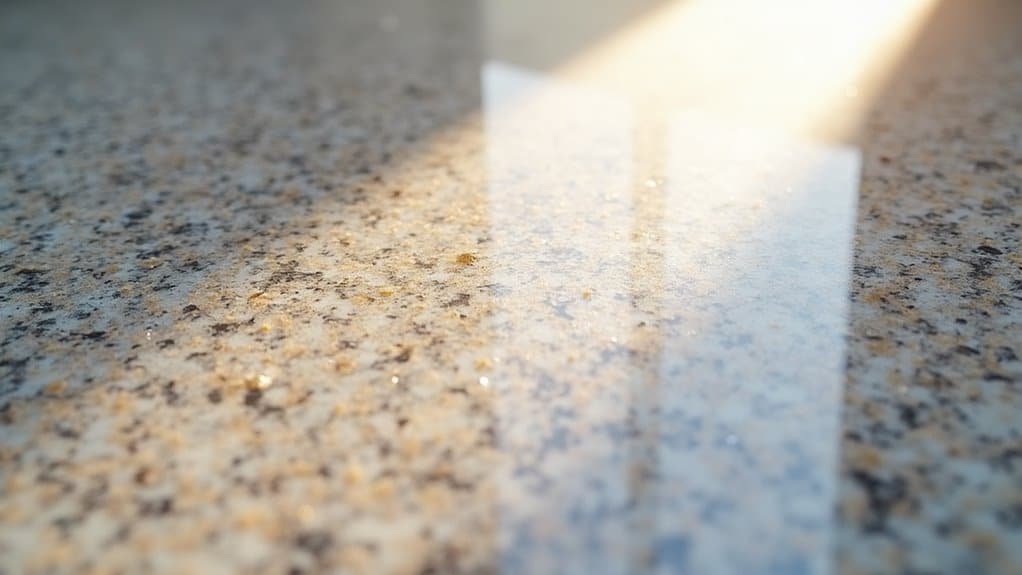The ideal weather for laying a tarmac driveway is when temperatures are between 10°C and 32°C. This range ensures proper compaction and adhesion, while steering clear of the problems that can arise from extreme heat, cold, rain, or high humidity. Spring and summer are the best seasons, as they typically offer dry conditions and warmer temperatures.
Additionally, proper ground preparation and the right equipment are essential for a durable finish. Understanding the various asphalt mixes and ground preparation techniques can further enhance your results.
Table of Contents
ToggleKey Takeaways
Best Weather Conditions for Laying a Tarmac Driveway
- The ideal temperature for laying tarmac is between 10°C and 32°C. This range helps ensure proper compaction and adhesion.
- Avoid laying tarmac in the rain, as this can compromise quality and hinder the curing process.
- Spring and summer are the best seasons for tarmac work, as the warmer, drier weather aids in effective curing.
- Keep an eye on humidity levels; high humidity can affect the adhesion and compaction of the tarmac.
- Make sure the ground is well prepared to prevent moisture issues that could impact the tarmac's durability.
Ideal Temperature Range for Laying Asphalt

When laying asphalt, it's crucial to work within the ideal temperature range for optimal performance and durability. Aim for an ambient temperature between 10°C and 32°C. This range helps the asphalt retain heat, ensuring maximum compaction and adhesion. The subgrade temperature should also be no less than 10°C to avoid rapid cooling. Heat the asphalt mix to between 105°C and 145°C for the best results. Additionally, temperatures below 10°C can prevent proper binding and lead to raveling. Keep an eye on temperature, as wind and sunlight can affect heating or cooling rates. By maintaining these temperatures, you improve the asphalt's binding properties, prevent material segregation, and ensure a long-lasting surface.
Impact of Weather Conditions on Asphalt Quality
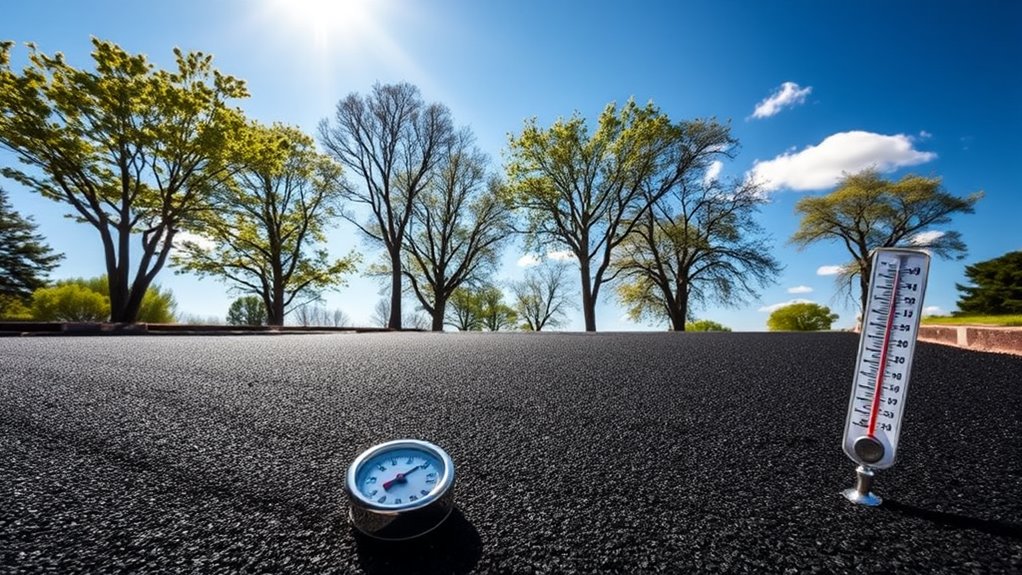
Weather conditions significantly affect the quality of asphalt, influencing its durability and performance. For instance, extreme temperatures can cause asphalt to either soften or become brittle. High humidity can hinder proper adhesion and compaction, making it difficult for the asphalt to set correctly. Additionally, strong winds can accelerate moisture evaporation, which disrupts the curing process and compromises the overall integrity of the asphalt. These factors are crucial to consider when planning roadworks or maintenance. Understanding how weather influences durability is essential for ensuring long-lasting pavement quality.
Temperature Effects
Temperature fluctuations can significantly affect asphalt quality, so it's crucial to understand the ideal conditions for laying a tarmac driveway.
The optimal temperature range for asphalt application is between 10 and 29 degrees Celsius. When temperatures rise, asphalt becomes more fluid, making it easier to mix and spread. This flexibility improves compaction, reducing air voids and enhancing durability. Additionally, proper temperature management is essential for achieving optimal asphalt performance and ensuring a uniform and dense pavement structure.
On the other hand, colder temperatures increase asphalt viscosity, making it stiff and difficult to compact, which can lead to cracking.
It's essential to monitor temperatures, as sudden changes can negatively impact the asphalt's curing process and overall quality. Keeping to ideal temperatures ensures better adhesion, density, and longevity of your driveway.
Humidity Challenges
Humidity presents notable challenges when installing asphalt, directly impacting adhesion and overall quality. High humidity can prevent proper bonding, leading to decreased durability and a higher risk of cracks and potholes.
Excess moisture also complicates compaction, which is crucial for pavement strength. Furthermore, elevated humidity speeds up oxidation, resulting in brittle asphalt over time.
To tackle these issues, effective humidity control is key. Using moisture measurement techniques can help assess aggregate conditions, ensuring proper grading and reducing energy use during the drying process.
It's important to schedule installations during dry weather, as wet conditions can undermine the foundation and cause long-term damage. By prioritising moisture management, you can significantly enhance the longevity and performance of asphalt.
Wind Influence
While it may not seem obvious, wind plays a significant role in the quality of asphalt during the paving process. High winds can cool the asphalt mix too quickly, which can affect compaction and bonding.
Additionally, wind can blow debris onto freshly laid asphalt, leading to surface imperfections.
To combat these issues, it's crucial to implement effective debris management and windbreak measures. Setting up windbreakers and using water trucks can help reduce airborne particles and dust, ensuring a smoother surface.
It's also wise to schedule paving during calmer weather and to carry out regular inspections for quality control.
Seasonal Considerations for Paving

Choosing the right season for paving is essential to ensure a successful tarmac installation. Weather patterns can significantly affect the curing and bonding process.
| Season | Considerations |
|---|---|
| Spring | Warmer temperatures and drier conditions help with curing. |
| Summer | Ideal months for paving; warm and dry weather promotes maximum curing. |
| Autumn | Can be suitable if conditions are warm and dry, but not as optimal as summer. |
| Winter | Cold temperatures can hinder curing, making it unsuitable for paving. |
In spring and summer, temperatures between 15°C and 30°C are ideal for laying tarmac. Avoid winter due to freezing conditions and be cautious during the rainy season. Remember that humidity and wind can also affect curing, so planning is key to achieving the best results.
Importance of Ground Preparation
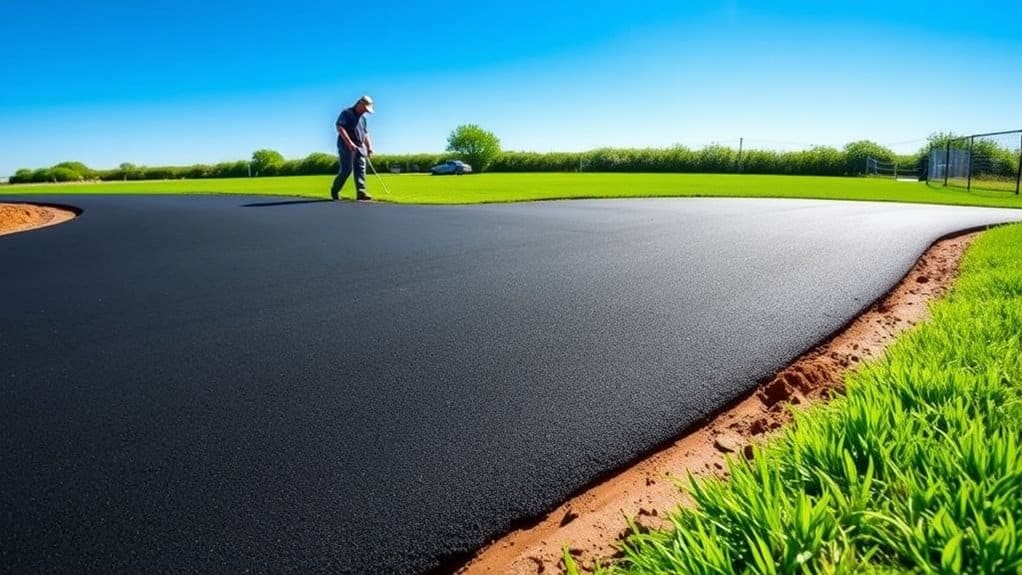
Ground preparation is essential for the long-term stability of your tarmac driveway.
Start by checking the soil stability and removing any vegetation or debris to establish a strong base.
For instance, if you leave roots or stones in place, they can lead to cracking and uneven surfaces over time.
Soil Stability Considerations
Soil stability is crucial for a reliable tarmac driveway installation, as proper ground preparation affects the surface's longevity and performance.
Begin by clearing away vegetation and debris to create a clean work area. Assess the soil type, as this will determine your compaction methods and materials.
Excavate to the correct depth to remove weak soil that may shift over time. Use appropriate compaction equipment, applying layered compaction to improve load-bearing capacity.
Incorporate effective drainage solutions, like soakaways, to manage water and prevent pooling. Ensuring the right gradient will also promote drainage, further enhancing soil stability.
Regular compaction testing is essential to achieve the ideal density, striking a balance between over- and under-compaction to maintain soil porosity and avoid future problems.
Surface Cleanliness Essentials
Ensuring surface cleanliness is crucial for the successful installation of a tarmac driveway. Start by removing any debris, such as vegetation, roots, or stones, that could affect the surface. A clean area is vital for achieving a smooth finish and reducing wear over time.
Next, apply proper surface grading techniques to create an even base, which will support the tarmac layers effectively. Compacting each layer properly is essential to prevent settling and water pooling.
Understanding Asphalt Thickness and Its Effects
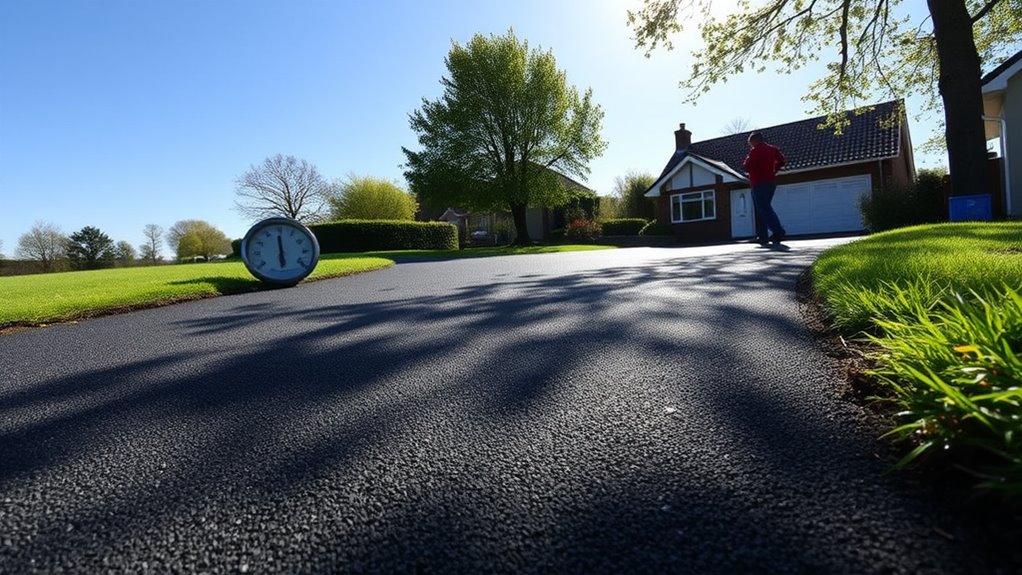
While many homeowners mightn't think much about asphalt thickness, it's crucial for the durability and lifespan of your driveway. Getting the thickness right ensures optimal performance and offers several benefits:
- Crack Prevention: Sufficient thickness helps prevent fatigue cracking and the formation of potholes.
- Load Resistance: A well-designed thickness can handle traffic and weather variations effectively.
- Long-Term Savings: Choosing the correct thickness can reduce maintenance costs and prolong the life of the asphalt.
For residential driveways, a thickness of 60 to 100 millimetres (approximately 2.5 to 4 inches) is typically recommended, while commercial driveways may need a thickness of 100 to 150 millimetres (around 4 to 6 inches).
Specialized Mixes and Equipment for Optimal Laying Conditions
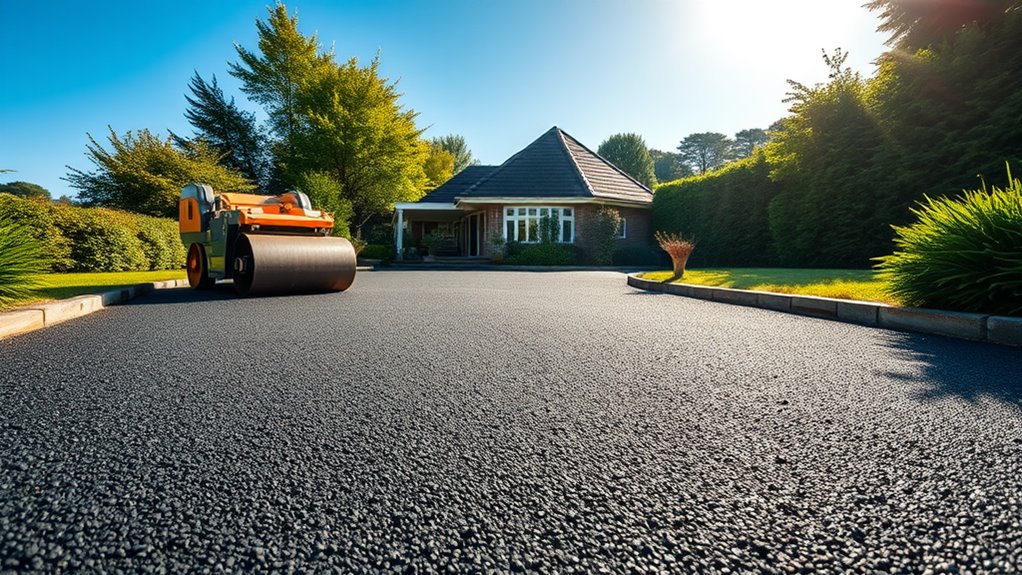
To achieve optimal laying conditions for tarmac, it's crucial to use specialised mixes and equipment tailored to the specific weather challenges you face. Warm mix asphalt, for instance, offers improved workability in colder temperatures, making compaction easier. Meanwhile, cold mix tarmac is versatile and can handle cooler conditions, but be cautious of rain.
| Mix Type | Key Features |
|---|---|
| Warm Mix Asphalt | Easier compaction, better adhesion |
| Cold Mix Tarmac | Versatile, suitable for cooler weather |
| High-Temperature Mix | Resistant to extreme heat |
| Aggregate Size | Finer aggregates provide a smoother finish |
Investing in the right compaction tools and keeping an eye on temperature will enhance the laying process, ensuring a durable tarmac driveway.
Frequently Asked Questions
Can I Lay Asphalt at Night or in Low Light?
Laying asphalt at night is not advisable due to poor lighting conditions. Working in low light makes it difficult to inspect the surface properly and achieve the right compaction, which can lead to defects and safety hazards. For the best results and quality assurance, it's important to carry out asphalt installation during daylight hours.
How Does Temperature Affect the Drying Time of Asphalt?
Think of baking bread; if it's too hot, it hardens quickly. Similarly, temperature plays a crucial role in the drying time of asphalt. The right warmth ensures proper evaporation, while colder conditions can slow the process, potentially compromising the structure. Striking the right balance is vital for a successful installation.
What Should I Do if It Rains During the Paving Process?
If it rains while you're paving, keep a close eye on the situation. Use tarps to protect the asphalt as it cures and act swiftly to prevent any separation of oils. Once the rain passes, check the surface to ensure it meets quality and stability standards.
Are There Any Specific Tools Needed for Home Asphalt Laying?
When laying asphalt, you'll require some basic equipment. Tools like rakes, tampers, and rollers are essential for ensuring proper levelling and compaction. Additionally, using specialised tools such as squeegees and brushes can significantly improve the surface finish and longevity of your drive.
How Long After Paving Can I Drive on the Asphalt?
You should wait at least 72 hours before driving on newly laid asphalt to ensure it cures properly. During this time, it's best to avoid heavy vehicles to prevent any damage to the surface. For example, if you've just had your driveway paved, keep off it with your car for three days to let it set.
Conclusion
In asphalt paving, timing is crucial. Just as a chef knows when to flip a pancake, you need to choose the right weather for laying your driveway. Aim for temperatures between 10°C and 25°C for the best results. Rain and extreme cold can negatively affect the quality of the asphalt, leading to cracks and a rough finish.
Prepare the ground properly and consider using a specialised mix to ensure your driveway lasts. With the right conditions, you'll have a smooth, durable surface that can withstand the test of time.
Prepare the perfect base for your resin bound stone installation and discover the crucial factors that ensure lasting durability.
Know where resin bound surfacing can transform spaces for both residential and commercial use, and discover the countless benefits that Read more
A stone carpet combines beauty and resilience in flooring, but what makes quartz floors uniquely beneficial? Discover the secrets behind Read more

